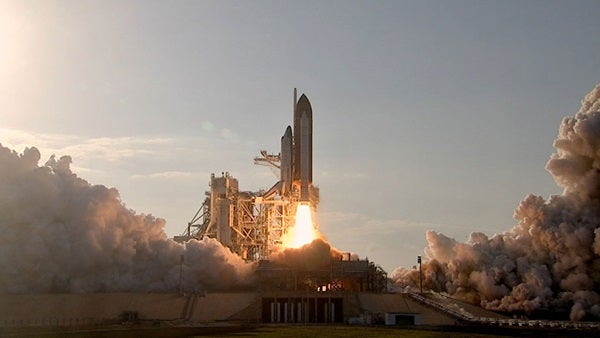The STS-133 mission is delivering the Permanent Multipurpose Module (PMM), a facility created from the Multi-Purpose Logistics Module named Leonardo. The module can support microgravity experiments in areas such as fluid physics, materials science, biology, and biotechnology. Inside the PMM is Robonaut 2, a dexterous robot that will become a permanent resident of the station. Discovery also is carrying critical spare components to the space station and the Express Logistics Carrier 4, an external platform that holds large equipment.
“With Discovery’s mission, the United States once again reaches for new heights, pushes the boundaries of human achievement and contributes to our long-term future in space,” NASA Administrator Charles Bolden said. “Discovery’s crew — including the first-ever dexterous robot crew member, Robonaut 2 — will continue America’s leadership in human and robotic spaceflight, and support important scientific and technical research aboard the space station.”
STS-133 Commander Steve Lindsey will command the flight. Pilot Eric Boe and Mission Specialists Alvin Drew, Steve Bowen, Michael Barratt, and Nicole Stott join him on the mission. Bowen replaced Tim Kopra as mission specialist 2 following a bicycle injury January 15 that prohibited Kopra from supporting the launch window. Bowen last flew on Atlantis in May 2010 as part of the STS-132 crew. Flying on the STS-133 mission will make Bowen the first astronaut ever to fly on consecutive missions.
The shuttle crew is scheduled to dock to the station at 2:16 p.m. Saturday, February 26. The mission’s two spacewalks will focus on outfitting the station and storing spare components outside the complex.
After completing the 11-day flight, the shuttle’s first landing opportunity at Kennedy is scheduled for 12:44 p.m. Monday, March 7. STS-133 is the 133rd shuttle flight, the 39th flight for Discovery, and the 35th shuttle mission dedicated to station assembly and maintenance.
The STS-133 mission is delivering the Permanent Multipurpose Module (PMM), a facility created from the Multi-Purpose Logistics Module named Leonardo. The module can support microgravity experiments in areas such as fluid physics, materials science, biology, and biotechnology. Inside the PMM is Robonaut 2, a dexterous robot that will become a permanent resident of the station. Discovery also is carrying critical spare components to the space station and the Express Logistics Carrier 4, an external platform that holds large equipment.
“With Discovery’s mission, the United States once again reaches for new heights, pushes the boundaries of human achievement and contributes to our long-term future in space,” NASA Administrator Charles Bolden said. “Discovery’s crew — including the first-ever dexterous robot crew member, Robonaut 2 — will continue America’s leadership in human and robotic spaceflight, and support important scientific and technical research aboard the space station.”
STS-133 Commander Steve Lindsey will command the flight. Pilot Eric Boe and Mission Specialists Alvin Drew, Steve Bowen, Michael Barratt, and Nicole Stott join him on the mission. Bowen replaced Tim Kopra as mission specialist 2 following a bicycle injury January 15 that prohibited Kopra from supporting the launch window. Bowen last flew on Atlantis in May 2010 as part of the STS-132 crew. Flying on the STS-133 mission will make Bowen the first astronaut ever to fly on consecutive missions.
The shuttle crew is scheduled to dock to the station at 2:16 p.m. Saturday, February 26. The mission’s two spacewalks will focus on outfitting the station and storing spare components outside the complex.
After completing the 11-day flight, the shuttle’s first landing opportunity at Kennedy is scheduled for 12:44 p.m. Monday, March 7. STS-133 is the 133rd shuttle flight, the 39th flight for Discovery, and the 35th shuttle mission dedicated to station assembly and maintenance.










